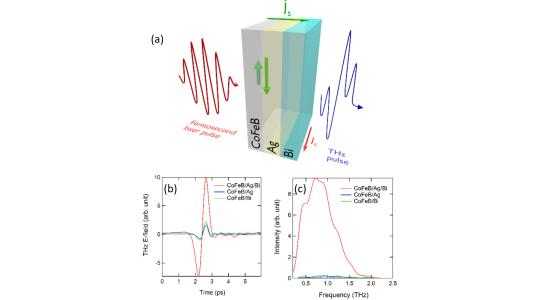
In a recent study published by Physical Review Letters, researchers in Argonne’s Materials Science division and at the Center for Nanoscale Materials, a U.S. Department of Energy Office of Science User Facility, demonstrate that interfacial spin-orbit coupling and ultrafast spin-charge current transfer can generate THz radiation.
Scientific achievement
Demonstration that interfacial spin-orbit coupling and ultrafast spin-charge current transfer can generate THz radiation.
Significance and impact
Interfacial spin-orbit coupling may lead to spintronics devices and new methods to study ultrafast spin-coupled ultrafast processes at interfaces.
Research details
- Ultrafast spin currents generated via optical excitation get converted into charge current pulses via interfacial spin-orbit coupling on ps time scales
- The observation is consistent with expectations from Rashba spin-orbit coupling
- Circular polarization of the incoming light results in a helicity-dependent rotation of the THz field
DOI: https://doi.org/10.1103/PhysRevLett.120.207207
Download this highlight https://anl.box.com/s/zklhv4iy7ltog6qv3fewjzzlp5j4zqbi
Argonne National Laboratory seeks solutions to pressing national problems in science and technology. The nation’s first national laboratory, Argonne conducts leading-edge basic and applied scientific research in virtually every scientific discipline. Argonne researchers work closely with researchers from hundreds of companies, universities, and federal, state and municipal agencies to help them solve their specific problems, advance America’s scientific leadership and prepare the nation for a better future. With employees from more than 60 nations, Argonne is managed by UChicago Argonne, LLC for the U.S. Department of Energy’s Office of Science.
The U.S. Department of Energy’s Office of Science is the single largest supporter of basic research in the physical sciences in the United States and is working to address some of the most pressing challenges of our time. For more information, visit https://energy.gov/science.